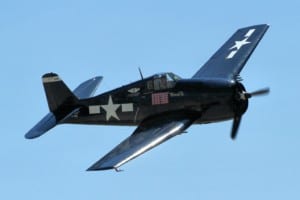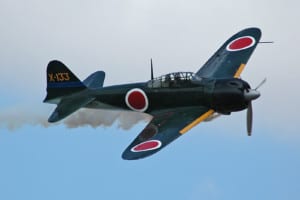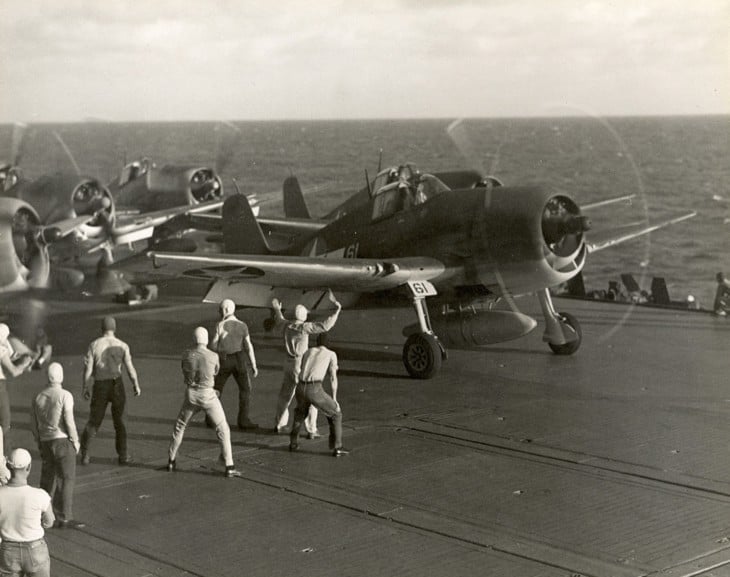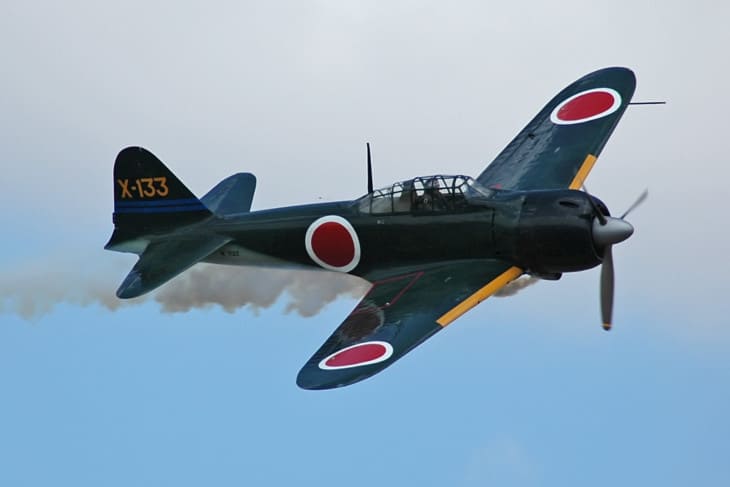Regarding fighter planes in World War II, two always come up: the F6F Hellcat and the A6M Zero. The Hellcat was a carrier-based fighter plane used by the United States Navy, while the Zero was a land-based fighter used by the Japanese Imperial Navy. Both planes were highly maneuverable and had powerful engines, but they differed in other ways. Curious? Read on.
| Aircraft: | Grumman F6F Hellcat | Mitsubishi A6M Zero |
|---|---|---|
| Photo: |
 |
 |
| Country: | United States | Japan |
| Manufactured: | from: 1942 to: 1945 | from: 1939 to: 1945 |
| ICAO: | F6F | A6M |
| Price: | $0.035 million | $ million |
| Avionics: | AN/APS-4 Radar | - |
| Engine: | 1x Pratt & Whitney R-2800 Double Wasp | 1x Mitsubishi NK1F Sakae 21 |
| Engine Type: | Piston | Piston |
| Power: | 2,000 horsepower | 1,130 horsepower |
| Max Cruise Speed: |
340 knots 630 Km/h |
288 knots 533 Km/h |
| Approach Speed (Vref): | 75 knots | 60 knots |
| Travel Range: |
950 Nautical Miles
1,759 Kilometers |
1,010 Nautical Miles
1,871 Kilometers |
| Fuel Economy: | - | - |
| Service Ceiling: | 37,000 feet | 33,000 feet |
| Rate of Climb: |
3650 feet / minute 18.54metre / second |
3090 feet / minute 15.70metre / second |
| Take Off Distance: |
475 metre 1,558.38 feet |
- |
| Landing Distance: |
570 metre 1,870.06 feet |
- |
| Max Take Off Weight: |
6,992 Kg 15,415 lbs |
2,796 Kg 6,164 lbs |
| Max Landing Weight: |
5,714 Kg 12,597 lbs |
- |
| Max Payload: |
1,800 Kg 3,968 lbs |
270 Kg 595 lbs |
| Fuel Tank Capacity: |
250 gallon 946 litre |
224 gallon 848 litre |
| Baggage Volume: | - | - |
| Seats - Economy: | 1 seats | 1 seats |
| Seats - Business Class: | - | - |
| Seats - First Class: | - | - |
| Cabin Height: | - | - |
| Cabin Width: | - | - |
| Cabin Length: | - | - |
| Exterior Length: |
10.24 metre 33.60 feet |
9.06 metre 29.72 feet |
| Tail Height: | 3.99 metre - 13.09 feet | 3.05 metre - 10.01 feet |
| Fuselage Diameter: |
1.5 metre 4.92 feet |
1.1 metre 3.61 feet |
| Wing Span / Rotor Diameter: |
13.06 metre 42.85 feet |
12 metre 39.37 feet |
| Wing Tips: | No Winglets | No Winglets |
| More Info: | Grumman F6F Hellcat | Mitsubishi A6M Zero |
|
Data presented is for entertainment purposes and should not be used operationally.
|
Other Grumman F6F Hellcat comparisons:
Other Mitsubishi A6M Zero comparisons:
The Grumman F6F Hellcat

The Grumman F6F Hellcat is arguably one of the most impressive fighter planes to come out of WWII. With a top speed of 611 km/h, a range of 1,520 km, and weighing in at 4,109 kg, it was a formidable opponent for the Japanese Mitsubishi A6M Zero.
The Hellcat featured a 13m wingspan powered by the Pratt & Whitney R-2800 Double Wasp engine. But beyond its impressive specs, the Hellcat was also proven to be an efficient and effective war machine. During its service, it shot down 5,271 enemy aircraft while only losing 270 of its own in combat.
American pilots had an impressive 19:1 kill ratio while flying the Hellcat. Truly, the Grumman F6F Hellcat proved to be a game changer for the United States Navy in WWII and will forever have a place in aviation history.
Why was the F6F Hellcat developed and built
The F6F Hellcat was designed as a better model to the earlier F4F Wildcat and created to oppose the Japanese Mitsubishi A6M Zero. The US Navy required a fighter that could at very least compete with, if not surpass, the capabilities of the Zero–and that is precisely what they received in the Hellcat. Its powerful engine allowed for higher speeds and greater maneuverability, while its reinforced armor and various weaponry options made it a formidable opponent in battle. Despite initial delays and production challenges, the Hellcat proved a crucial asset during WWII, ultimately becoming the most successful aircraft in terms of enemy kills.
What purpose did the F6F Hellcat serve
The role of the F6F Hellcat during World War II was as a carrier fighter, and it excelled in this area. The design was rugged and well-suited for the task, and it could take on Japanese fighters that were fast and agile. Its powerful engine and sturdy design could also withstand heavy damage and bring pilots back home safely. J
just one squadron of Hellcats could claim credit for shooting down over 1,400 enemy planes throughout the war. In addition to its prowess in air combat, the Hellcat was also used as a bomber escort and occasionally even dive-bombed targets.
Overall, its versatility and effectiveness in battle solidified the Hellcat’s place in history as one of the most successful fighters of World War II.
The Mitsubishi A6M Zero

The A6M Zero was a formidable foe in World War II, renowned for its agility and long-range capabilities. It could fly at speeds of up to 565 km/h and had a range of more than 2,000 miles, allowing it to strike targets deep within enemy territory.
The Zero’s design was ahead of its time, with features such as a monocoque fuselage and retractable landing gear. However, as the war progressed and technology advanced, the Zero’s lack of armor and powerful armament became apparent.
Despite this vulnerability, the A6M Zero remained in service until the end of the war and remained a symbol of Japanese military power.
Also Read: The Japanese Fighters of World War II
Why was the A6M Zero developed and built
The A6M Zero, Japan’s famous World War II fighter plane, was developed and built with a specific purpose: superiority on the Pacific battlefield. The Japanese emphasized agility and maneuverability over durability, resulting in its lightweight design.
However, this also resulted in flaws that would become apparent as the war progressed and newer Allied fighters were introduced. Its lack of hydraulic boosting for its ailerons and rudder left it at a disadvantage against these newer aircraft.
Despite its eventual limitations, the A6M Zero was still able to hold its own during the war and undeniably impact history.
What purpose did the A6M Zero serve
The Mitsubishi A6M “Zero” is best known for its role in World War II as the primary fighter aircraft of the Imperial Japanese Navy.
Its superior maneuverability and long range made it a deadly opponent, and it notably saw use during Japan’s attacks on Pearl Harbor, the Philippines, Midway, and Leyte Gulf.
However, as the war progressed and newer aircraft were introduced, its weaknesses, such as lack of armor and low speed, became increasingly apparent. Despite this, it continued to serve faithfully until the war’s end in various roles, such as suicide attack aircraft and reconnaissance.
In post-war years, many were captured and utilized by other nations for training purposes before eventually being phased out entirely in the 1950s.
How are the F6F Hellcat and A6M Zero different?
While both the F6F Hellcat and A6M Zero were highly-valued fighter planes during World War II, they differed in a few key ways.
The Hellcat was larger than the Zero, with a heavier engine and bigger wingspan, allowing it to reach higher speeds and carry more armaments.
Additionally, the Hellcat featured more robust armor and could endure greater damage before going down.
Despite being heavier, the Hellcat had better maneuverability and could turn tighter circles in combat. On the other hand, the Zero was known for its exceptional range and could stay in the air longer without needing to refuel. Ultimately, though the Zero was perhaps more highly-regarded before the war began, it couldn’t match the triumphs of the F6F Hellcat in battle.
How are the F6F Hellcat and A6M Zero similar?
Both were highly maneuverable and able to outperform their opponents in dogfights. They also had similar maximum speeds, with the Hellcat reaching 357 miles per hour and the Zero reaching 335 miles per hour. Both planes also saw extensive use during WWII and were two of the most widely produced fighter planes of their time.
What’s better about the F6F Hellcat?
Features of this plane include:
Development:
The F6F Hellcat was developed as a response to the Japanese A6M Zero, which had previously been thought to be unbeatable.
Design:
The F6F Hellcat’s design was more robust than the Zero’s, with stronger armor and more powerful armaments.
Performance:
In terms of performance, the Hellcat could outmaneuver Zero and reach higher speeds.
What’s better about the A6M Zero?
Some advantages of the A6M Zero include the following:
Agility:
The Zero was known for its agility and maneuverability, which allowed it to perform well in dogfights.
Range:
The Zero had a longer range than the Hellcat, meaning it could stay in the air longer.
Conclusion
The F6F Hellcat and A6M Zero were excellent fighter planes during World War II. However, the Hellcat had better armor and performance, while the Zero had greater agility and range. Ultimately, the best plan depends on the specific situation and needs of the pilot.


